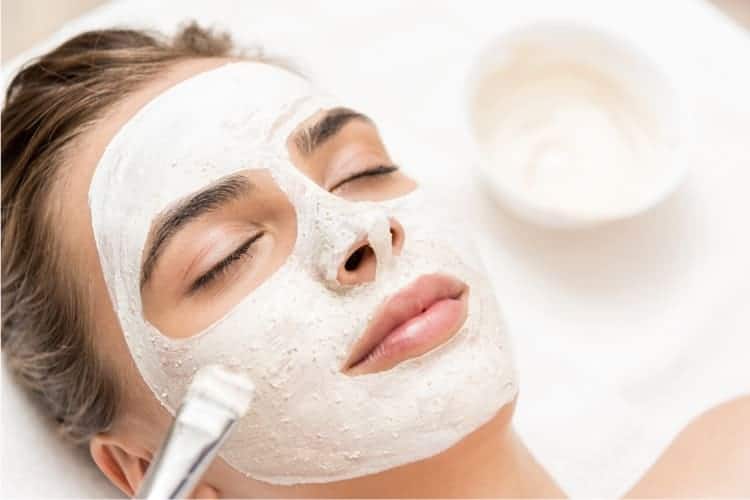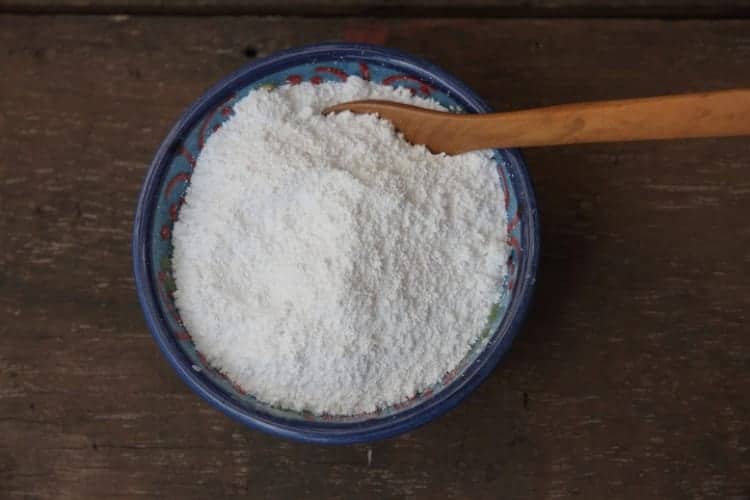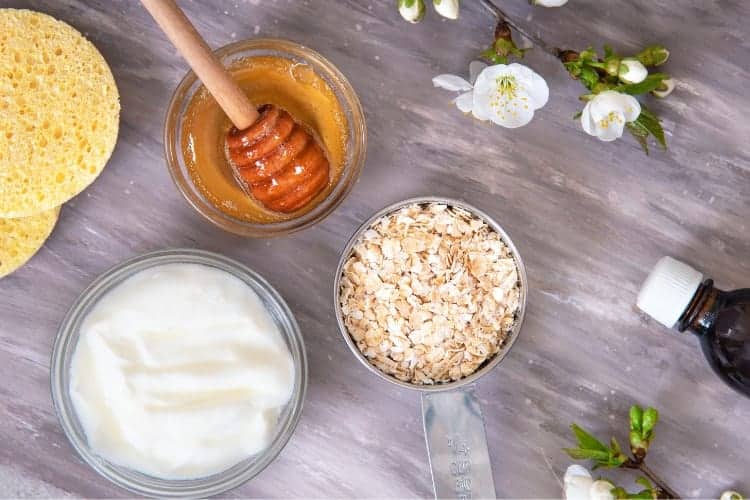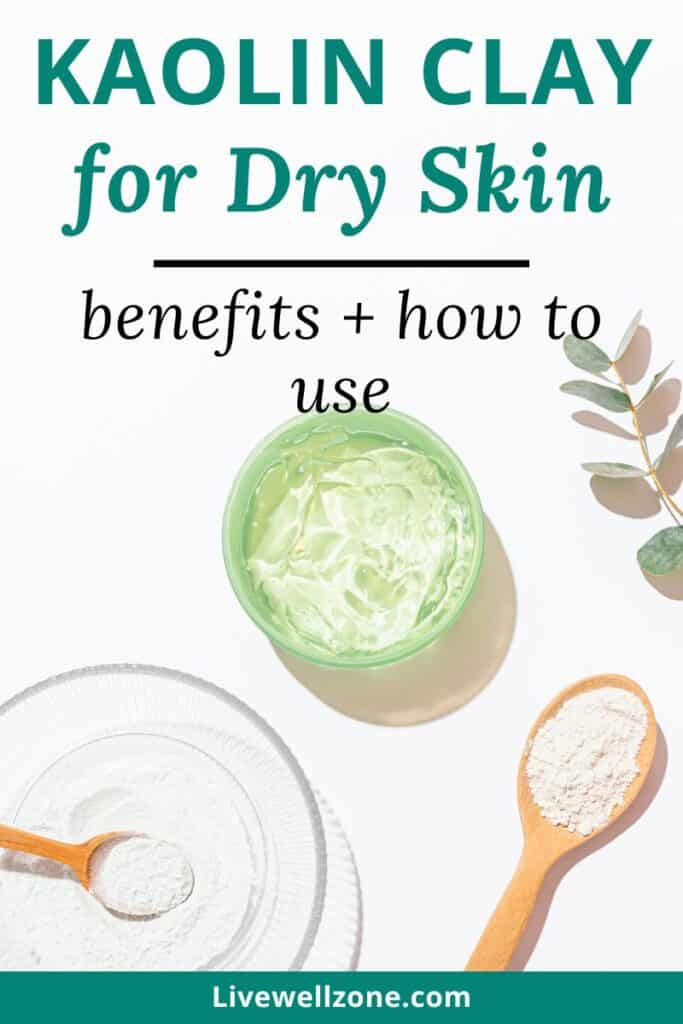
Curious about the benefits of a kaolin clay mask for dry skin, as well as how to use it? Well, you’re in the right place!
Also known as white cosmetic clay or china clay, kaolin is a very fine, powder-soft clay with a long history of use in China. In fact, the name kaolin comes from Kao-ling, where this clay was mined for many centuries.
These days the kaolin that is sold for cosmetic purposes comes from various parts of the world, but they all have one thing in common: they contain skin-friendly minerals and a natural balancing effect that rejuvenates dry skin.
So, in this post, we’re going to look at:
- The main benefits of kaolin for dry skin.
- How often to use a kaolin clay mask.
- Tips for making your own soothing kaolin clay mask.
IS KAOLIN CLAY GOOD FOR DRY SKIN?

Of all the clays, kaolin is particularly beneficial for dry skin because it has adsorbent properties. This means that unlike other clays – which are absorbent (i.e. remove moisture) – kaolin provides all the benefits of clays, without excessive water or moisture loss.
Now let’s take a closer look at the ways in which kaolin clay is good for dry skin.
1. Removes Impurities
One of the main benefits of using clays is that they can penetrate the deeper layers of skin.
This is important for dry skin because sometimes dry skin is caused by impurities that are clogging up your pores.
So, regular use of a kaolin clay mask is an effective way to draw out those toxins or impurities.
As a result, your pores will be able to breathe and your skin will be able to naturally balance out oil production (so your face won’t feel too dry or too oily).
2. Mild Absorbent Properties
When you have dry skin, one of the downsides of using clays is that some of them are highly absorbent. Meaning that, along with removing impurities, clays can also remove too much oil and moisture from the skin.
And that’s the complete opposite of what you want when your skin is already dry.
Thankfully, kaolin clay is the mildest of all the clays. So, yes, it’s great for removing the junk that your skin doesn’t need.
And it does this without being nearly as stripping as other clays (like bentonite, for example)
NOTE: kaolin clay comes in various colors including white, yellow red, pink and green. White kaolin is the absolute gentlest of them all. Use this if your skin is particularly dry and sensitive. The darker the colors, the more drying the kaolin will be.
3. Lowers Skin Inflammation
Kaolin has a natural anti-inflammatory effect that makes it soothing for any kind of swelling, redness or acne.
In addition, regular use of kaolin is also great for preventing new pimples and other signs of topical inflammation from popping up.
4. Works As A Gentle Exfoliant and Cleanser
Because of it’s very fine and powdery texture, kaolin clay works well as a non-abrasive exfoliant and cleanser.
In fact, if you have a hard time finding a scrub or cleanser that is gentle enough for your skin, then kaolin’s gentle touch just might be what you need.
Regular use of kaolin allows you to clean your skin and encourage cell turnover, without any harsh chemicals.
5. Stimulates Blood Flow
When you apply a kaolin clay mask, you might feel a slight pulsating effect on your face.
This is because kaolin stimulates blood flow and therefore helps to tone and rejuvenate the skin (i.e. give you that bright, radiant glow).
HOW DO YOU USE KAOLIN CLAY FOR DRY SKIN?
The best, and easiest, way to use kaolin clay for dry skin is to make a mask consisting of equal parts clay and water.
Here’s a basic kaolin clay mask recipe that you can use on dry skin.
Ingredients
2 tablespoons white kaolin clay
2 tablespoons distilled water
Glass bowl and spatula for mixing
Instructions
- Combine the ingredients in a bowl.
- Mix to form a smooth paste.
- Apply to a clean face and neck.
- Allow to sit for approximately 5 to 10 minutes. DON’T allow the mask to dry/harden.
- Rinse off with warm water.
- Follow with a toner (if you use one) and a nourishing moisturizer.
WHAT DO YOU MIX KAOLIN CLAY WITH WHEN APPLYING IT ON DRY, DEHYDRATED SKIN?

The fun thing about making your own kaolin clay mask is that you can really personalize it to match your skin’s current needs.
So, whether you’re looking to fade dark spots, smooth out fine lines or rehydrate your skin, there are plenty of fun natural ingredients that can you can add to the basic kaolin clay mask recipe. Here are 6 to choose from.
1. Honey
- Supports cell turnover, which is helpful for acne scars and dark spots.
- Natural humectant moisturizer, which means it attracts moisture to the skin.
- Soothes inflamed skin.
- Natural spot treatment for acne.
Please note that the honey you buy should be raw and unpasteurized because it contains more skin-friendly nutrients (source).
2. Hibiscus Powder
- Rich in mucilage which is a viscous fluid that many plants produce. The mucilage naturally hydrates and moisturizes the skin.
- Supports collagen and elastin levels, which are necessary for firmness and elasticity.
- High in vitamin E which keeps the skin smooth and supple.
- Rich in antioxidants that prevent premature aging and inflammation.
3. Almond Oil
- Natural emollient that softens and moisturizes skin.
- Gentle enough to use on all skin types including sensitive and inflamed skin.
- Soothes itching, dryness and irritation.
- Contains vitamin E and K, as well as omega fatty acids.
NOTE: if you’re allergic to nuts and can’t use almond oil, try substituting with hemp seed or grapeseed oil.
4. Hydrosols
Hydrosols are a by-product of essential oil distillation. While essential oils contain mainly lipophilic (fat-loving) molecules, hydrosols contain mainly hydrophilic (water-loving) molecules from the plant.
Not only are they much gentler than essential oils, they also:
- Soothe topical inflammation.
- Support healthy moisture levels.
Some hydrosols to choose from include chamomile, cornflower, lavender and rosewater.
5. Yogurt
- Contains lactic acid to help with exfoliation, skin renewal and hydration.
- Rich in live cultures (friendly bacteria) that help to cool down inflamed skin.
6. Oatmeal
- Natural emollient and moisturizer.
- Contains polysaccharides (such as beta-glucans) that have both antioxidant and anti-inflammatory properties. Beta glucans are also a humectant i.e. they attract moisture to the top layers of the skin (source).
As you can see there are plenty of amazing natural ingredients that you can add to your clay mask!
If you’re not sure where to start, go with the simple, everyday ingredients like almond oil, honey or yogurt.
They will balance out your kaolin clay mask so that you get a nice dose of purification and moisturization.
HOW OFTEN SHOULD YOU USE A KAOLIN CLAY MASK FOR DRY SKIN?
When using a kaolin clay mask on dry skin, it’s best to start off by applying it just once a week. This minimizes the risk of over drying your skin. If you find that your skin tolerates the kaolin mask well, then you can try increasing the frequency to twice a week.
Remember that kaolin is still a clay (albeit a gentler one). And clays are an intense treatment for the face.
So, it’s important not to overdo it.
FAQs ABOUT KAOLIN CLAY MASK FOR DRY SKIN
Do clay masks shrink pores?
Yes, clay masks are beneficial for shrinking or tightening pores. This is because they soak up excess oil that clogs up pores and they ultimately help to tighten skin.
Which is better: kaolin or bentonite?
If you have dry or very sensitive skin, then kaolin is a great choice because it’s less harsh. On the other hand, if your skin tends to be oily or you have large pores, then bentonite is a better option. This is mainly because bentonite is much more absorbent and drying, making it more suitable for skin that produces a lot of sebum.
CONCLUSION
As you can see, kaolin powder is an overall skin balancer that purifies, soothes inflammation and stimulates blood flow.
And even though a kaolin mask alone is worth the effort, you can intensify its healing effects by adding in other nourishing ingredients like honey, hibiscus, yogurt and much more.
So, go ahead and start experimenting to see which combos your skin likes. And if you need more recipes to get you started, then make sure to check out this post on homemade clay masks for dry skin.

You Might Also Enjoy:
Natural Skin Care Routine For Dry Skin: A Complete Guide
What to Mix with Bentonite Clay For A Face Mask: 13 Skin-Loving Ingredients
What To Do Before and After Using A Clay Mask On Face: Step by Step Guide
5 Things to Know Before Using Clay for Dry Skin
Which Is Better: Face Scrub Or Face Mask?

